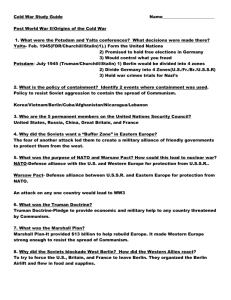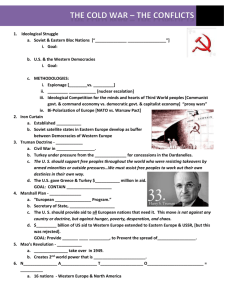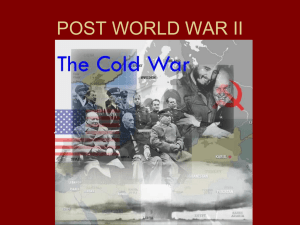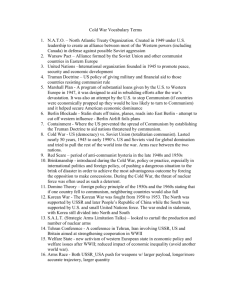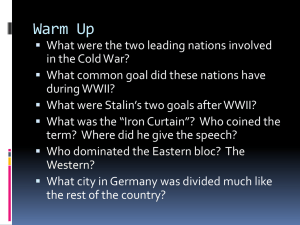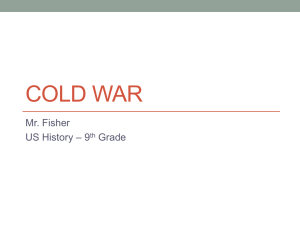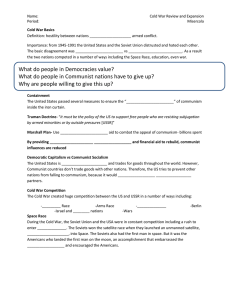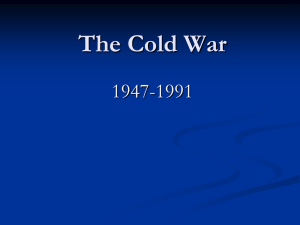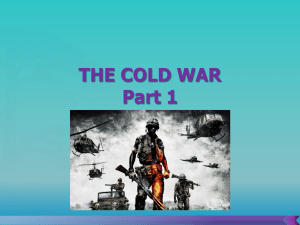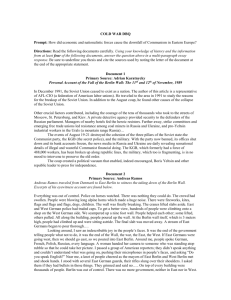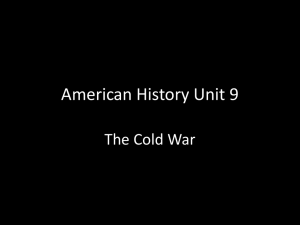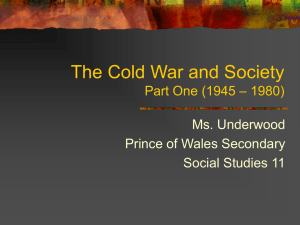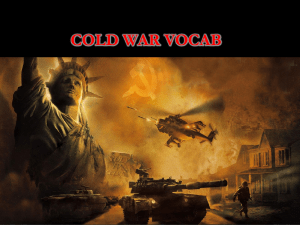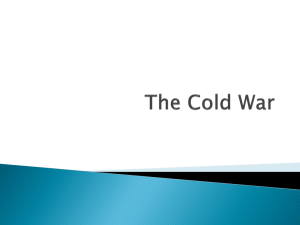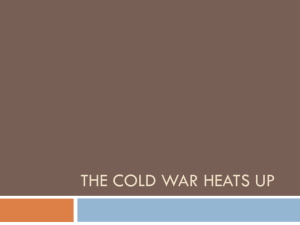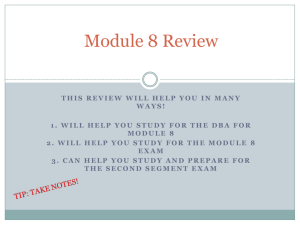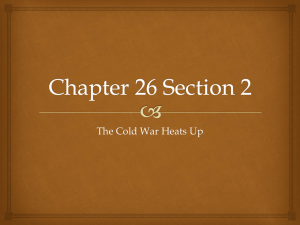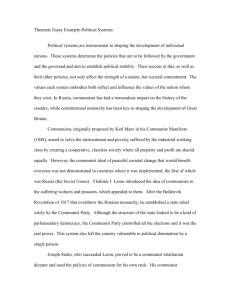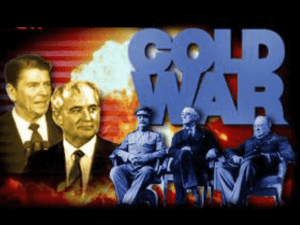Regents Review Unit 7 Answers
advertisement
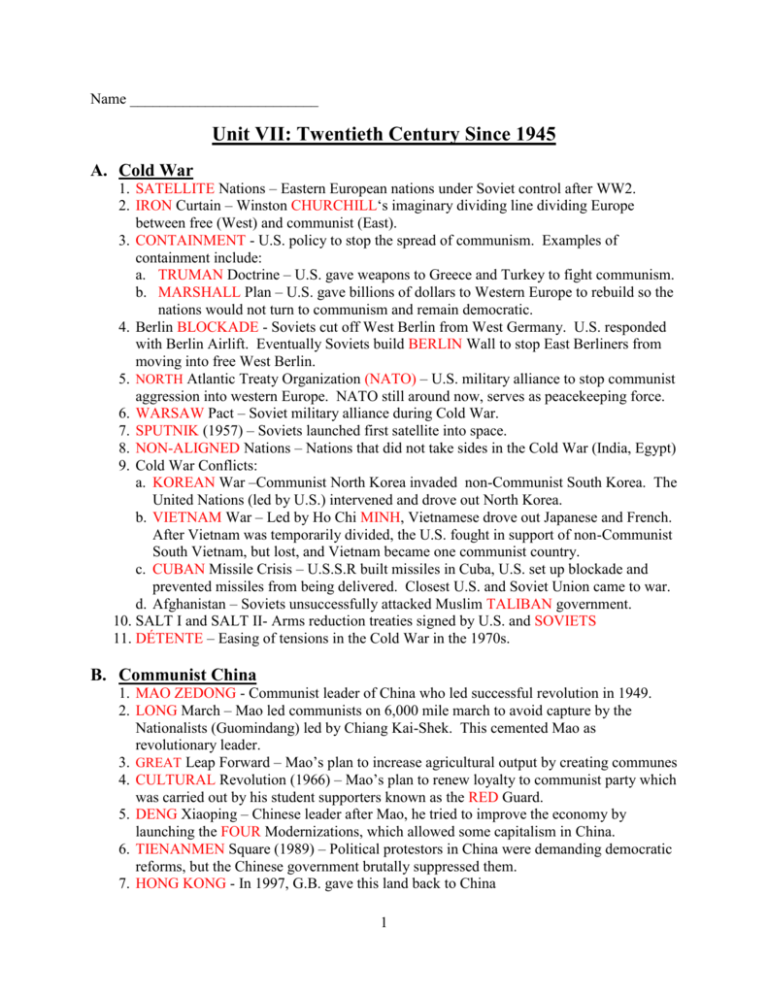
Name _________________________ Unit VII: Twentieth Century Since 1945 A. Cold War 1. SATELLITE Nations – Eastern European nations under Soviet control after WW2. 2. IRON Curtain – Winston CHURCHILL‘s imaginary dividing line dividing Europe between free (West) and communist (East). 3. CONTAINMENT - U.S. policy to stop the spread of communism. Examples of containment include: a. TRUMAN Doctrine – U.S. gave weapons to Greece and Turkey to fight communism. b. MARSHALL Plan – U.S. gave billions of dollars to Western Europe to rebuild so the nations would not turn to communism and remain democratic. 4. Berlin BLOCKADE - Soviets cut off West Berlin from West Germany. U.S. responded with Berlin Airlift. Eventually Soviets build BERLIN Wall to stop East Berliners from moving into free West Berlin. 5. NORTH Atlantic Treaty Organization (NATO) – U.S. military alliance to stop communist aggression into western Europe. NATO still around now, serves as peacekeeping force. 6. WARSAW Pact – Soviet military alliance during Cold War. 7. SPUTNIK (1957) – Soviets launched first satellite into space. 8. NON-ALIGNED Nations – Nations that did not take sides in the Cold War (India, Egypt) 9. Cold War Conflicts: a. KOREAN War –Communist North Korea invaded non-Communist South Korea. The United Nations (led by U.S.) intervened and drove out North Korea. b. VIETNAM War – Led by Ho Chi MINH, Vietnamese drove out Japanese and French. After Vietnam was temporarily divided, the U.S. fought in support of non-Communist South Vietnam, but lost, and Vietnam became one communist country. c. CUBAN Missile Crisis – U.S.S.R built missiles in Cuba, U.S. set up blockade and prevented missiles from being delivered. Closest U.S. and Soviet Union came to war. d. Afghanistan – Soviets unsuccessfully attacked Muslim TALIBAN government. 10. SALT I and SALT II- Arms reduction treaties signed by U.S. and SOVIETS 11. DÉTENTE – Easing of tensions in the Cold War in the 1970s. B. Communist China 1. MAO ZEDONG - Communist leader of China who led successful revolution in 1949. 2. LONG March – Mao led communists on 6,000 mile march to avoid capture by the Nationalists (Guomindang) led by Chiang Kai-Shek. This cemented Mao as revolutionary leader. 3. GREAT Leap Forward – Mao’s plan to increase agricultural output by creating communes 4. CULTURAL Revolution (1966) – Mao’s plan to renew loyalty to communist party which was carried out by his student supporters known as the RED Guard. 5. DENG Xiaoping – Chinese leader after Mao, he tried to improve the economy by launching the FOUR Modernizations, which allowed some capitalism in China. 6. TIENANMEN Square (1989) – Political protestors in China were demanding democratic reforms, but the Chinese government brutally suppressed them. 7. HONG KONG - In 1997, G.B. gave this land back to China 1 C. Collapse of Imperialism 1. India gains independence: a. Groups pushing for independence in India(INDIAN National Congress and the MUSLIM League) got their wish in 1947 when G.B. granted India independence. b. India was split into 2 nations: India and Muslim-led PAKISTAN c. As a result, millions of people migrated due to religion (Hindus wanted to be in INDIA, Muslims wanted to be in PAKISTAN). d. Jawaharlal NEHRU - First prime minister of India. 2. African Independence Movements: a. PAN-Africanism – Movement to promote a unified Africa Independence Movements in Africa: Case Studies Ghana Kwame NKRUMAH - Led nationalist movement in Ghana to free country from British control. Kenya MAU MAU - Group in Kenya attempting to drive out the British. JOMO Kenyatta – Leader of Kenyan independence movement. Algeria Muslim nationalist movement led to long, bloody war to drive out the FRENCH South Africa APARTHEID - Policy of segregation in South Africa. Nelson MANDELLA - Black leader jailed for trying to end apartheid, later became president of South Africa. Desmond TUTU - Black South African who also protested apartheid. F.W. dE KLERK - White president of South Africa, ended apartheid in 1990. Rwanda After independence, HUTU launched a genocide against the TUTSI 3. Cambodia: a. KHMER Rouge – Communist guerilla fighters, gained control of Cambodia in 1969. b. POL POT - Cambodian dictator who launched genocide that killed over 1 million Cambodians during his attempt to drive out Western influence. 4. Myanmar: a. BURMA - Former name for the country of Myanmar. b. Aung Sang Suu KYI - Woman who won election in 1990, but was later placed under house arrest. Today she still fights for democracy in Myanmar. D. Conflict and Change in the Middle East 1. Islamic FUNDAMENTALISM - Applying traditional Islamic religious values to gvt. Key Areas of Conflict in the Middle East Israel BALFOUR Declaration – British promised Jews a homeland in Palestine in return for help in WWI, but they also promised same to Palestinian Arabs Today, Israelis and Palestinians still fight over land and religious difference. 2 Iran Iraq SHAH Reza Pahlevi modernized Iran and was supported by Western nations. Islamic clergy opposed him, and led by AYATOLLAH Khomeini, the Shah was overthrown in 1979. Saddam HUSSEIN - Longtime dictator of Iraq who denied his citizens basic human rights. Fought war in 1980s vs. Iran, and defeated twice by the U.S. (Persian Gulf War 1991, and again in 2003 in which he was ousted). E. Collapse of the Soviet Union 1. Mikhail GORBACHEV - Soviet leader beginning in 1985, he began policies that allowed some freedom in the U.S.S.R., eventually leading to its break up. a. PERESTROIKA - Economic policy to allow some capitalism in the Soviet Union. b. GLASNOST - “Openess,” which brought some freedom and an end to censorship. 2. Boris YELTSIN - When Gorbachev resigned in 1991 and the Soviet Union broke up, Yeltsin became the first president of Russia. 3. Lech WALESA - Led SOLIDARITY movement in Poland (a labor group fighting for freedom in Poland). In 1989 he became the first democratically elected president. 4. BERLIN Wall torn down in 1989, and Germany was reunited under democratic rule. 5. After the fall of communism in the late 1980s, many political borders changed. An example is in YUGOSLAVIA, a country that broke up and new countries such as Croatia, Slovenia, and Bosnia-Herzegovena were formed. 6. Since the fall of communism, religious and ethnic tensions have developed in places such as Ukraine, Chechnya, Azerbaijan, and Bosnia (where an “ETHNIC Cleansing” took place – this is the same as a genocide). F. Political and Economic Changes in Latin America Case Studies in Latin America Argentina Juan PERON - Repressive leader who racked up huge debt before losing power in a coup. Cuba FIDEL Castro – Led peasant rebellion to gain control in 1959, and soon gained support from communist Soviet Union, which would lead to the Cuban Missile Crisis between the U.S. and the U.S.S.R. Nicaragua Civil war between the Sandinistas (communists) and the Contras (supported by the U.S.) Mexico PRI - Political party that has dominated Mexican government NAFTA - Free trade agreement between Mexico, U.S., and Canada. G. Economic Trends 1. Rapid INDUSTRIALIZATION in the world has led to a larger gap between rich and poor. 2. GLOBALIZATION - Increased interaction among people, companies, and governments of different nations. 3 Key Regional Organizations in the World Today NAFTA Free trade b/t U.S., Canada, and Mexico, which means reduced trade barriers (lower TARIFFS) and more interdependence among nations. European Economic union of European nations with low tariffs and common Union (EU) currency, the EURO OPEC Group of OIL producing countries (mostly from the Middle East) that determines the supply of oil and thus sets its price. 4
